In this tutorial, you will learn how to list files, folders, and subfolders using Windows CMD commands and PowerShell.
I’ll also demonstrate using the NTFS Permissions Tool, which is a graphical program that displays the permissions on folders and subfolders.
In this article
- List Files and Folders using the DIR Command
- Display Folder Structure using TREE Command
- Powershell List Folders and Subfolders
- Get Folder and Subfolder NTFS Permissions
Check it out.
List Files and folders using the DIR Command
The dir command is built into all versions of Windows. It is an easy to use command to list files, folders, and subfolders from the Windows command prompt.
Let’s look at some examples.
Example 1. List files and folders in the current directory
To list the files and folders in the current directory, open the Windows command prompt, enter dir and press enter. The dir command by default does not display subfolders.
dirIn this example, my current location is c:\it, so when I run the dir command it will list everything in this folder.
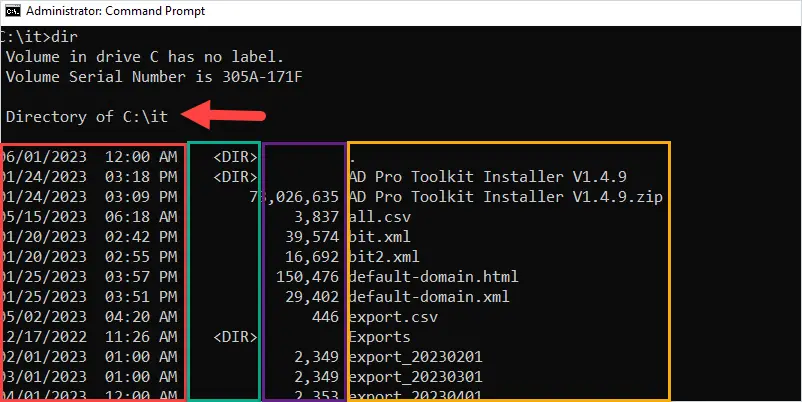
I have put the command output into colored boxes to explain what each column means.
- Red = This column is the last modified date of the file or folder
- Green = Indicates if the item is a folder, folders are labeled with DIR
- Purple = The size of the file
- Yellow = Name of the file or folder.
Example 2. List subfolders
Use the /s option to include subfolders.
dir /sI ran the command from the c:\it location and it lists all subfolders and files from this directory. I’ve highlighted some of the subfolders in the screenshot below.
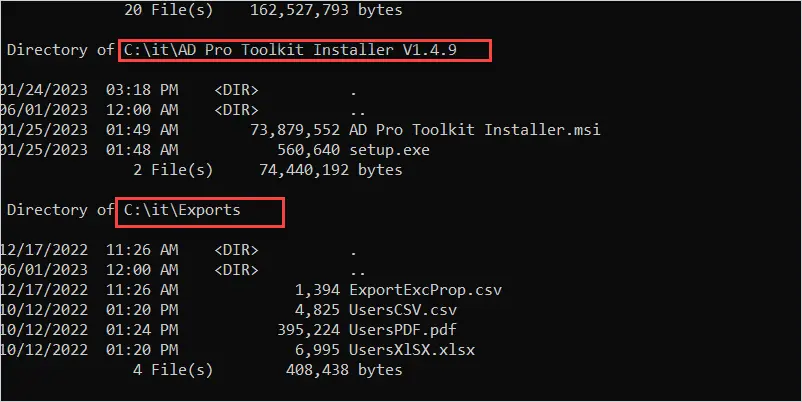
Example 3. Specify a directory path
To list files and folders from a specific directory enter the complete directory path.
dir /s c:\itFor example, if my current location is the root of c: and I type dir /s c:\it the command will display the items from the c:\it directory.
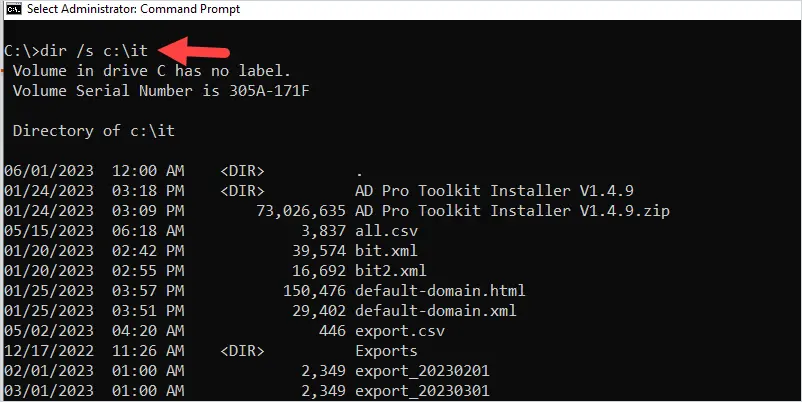
Example 4. Export list of files and folders
To export the screen output use the command below. You can name the file whatever you want, in this example, I named the file files2.txt
dir > files2.txtThe file will be saved to the current directory.

Pretty easy right?
I covered some of the most basic dir command options. To see a full list of options type dir /? and press enter.
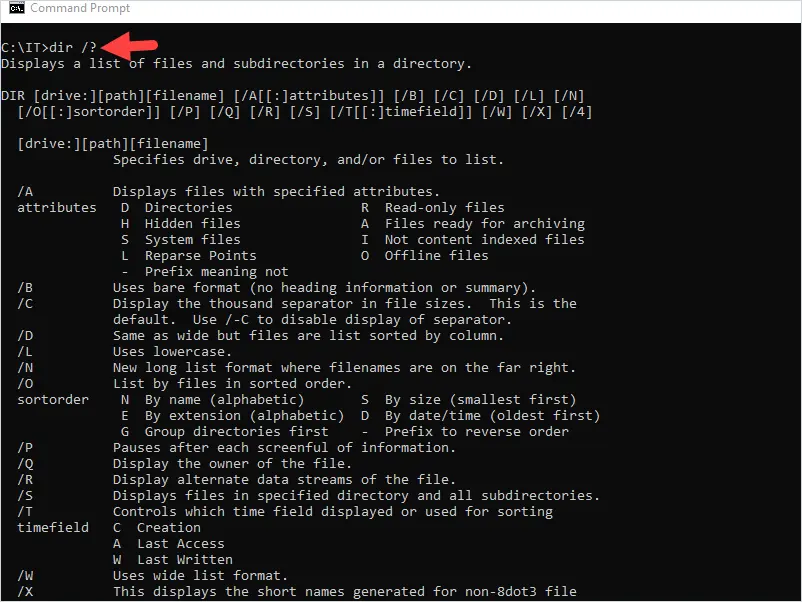
To learn more about the dir command check out the Microsoft dir documentation page.
Display Folder Structure using TREE Command
The tree command is another built-in Windows command. This command will display the contents of a directory in a tree structure. This can be useful to give you an overview of the folder layout.
You must specify a path or this command will start at the root of c
Example 1. List all folders and subfolders using TREE
To list all folders and subfolders enter the tree command and the path.
tree c:\it\toolkit
Example 2. List all folders and files using TREE
To include files with the tree command use the /f option.
tree c:\it\toolkit /f
In my experience, I never use the tree command. I find it more useful when a command provides more details like modified dates, permissions, ownership, and so on. If you just need to see the files and folders with no other details then this is a great option.
Powershell List Folders and Subfolders
You can use the Get-Childitem PowerShell cmdlet to list files and folders. The Get-Childitem cmdlet is similar to dir but much more Powerful.
Let’s look at some examples
Example 1. List files and folders using Get-Childitem
This example gets the folder contents from a specific directory
Get-ChildItem -path c:\it\toolkit
By default, the Get-ChildItem cmdlet lists the mode, LastWriteTime, Length, and Name of the filer or folder.
The mode can be the following:
- l = Link
- d – directory
- a = archive
- r = read-only
- h = hidden
- s = system
Example 2. Get subfolders using Get-ChildItem
Use the -Recurse option to get subfolders and files.
Get-ChildItem -path c:\it\toolkit -Recurse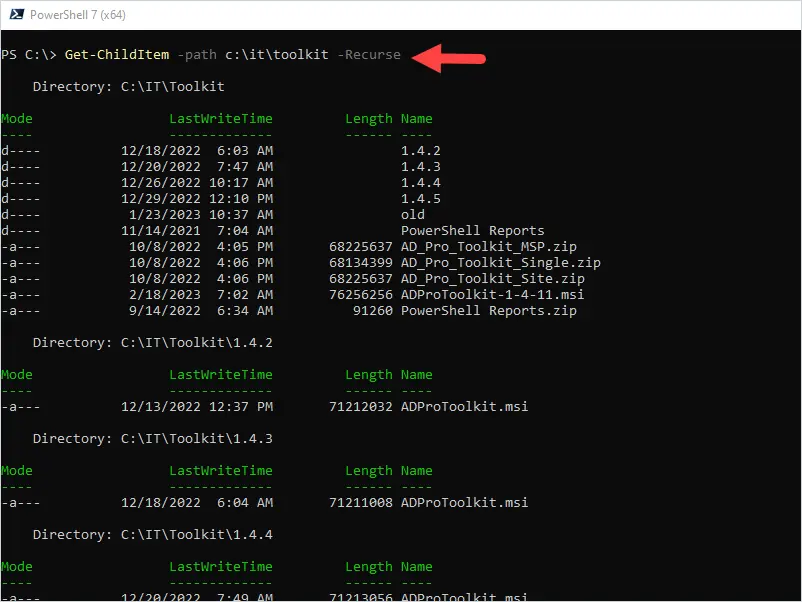
Example 3. Get items using the Depth parameter
You can use the -Depth parameter to control how many subfolders deep to include in the list.
Get-ChildItem -Path C:\it -Depth 2Example 4. PowerShell List only specific file types
In this example, I will list only files that end in a .msi file extension. This will search all subfolders in the directory path.
get-childitem -path c:\it -include *.msi -recurse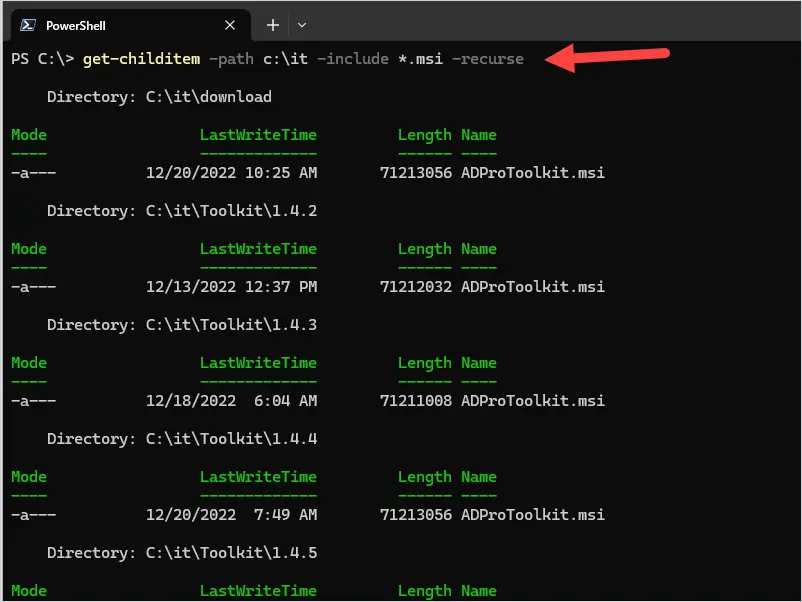
Example 5. PowerShell List only folder or files name
The -Name parameter will only return the file or folder name.
Get-ChildItem -path c:\it\toolkit -Name
Example 6. PowerShell List all Files and Folder Details
To display all details of a file or folder use the fl option.
Get-ChildItem -path c:\it\toolkit | FLYou can see below this command will display additional details, if there are any.

Example 7. PowerShell count files and folders
To get a count of the files and folders use the measure-object option.
Get-ChildItem -path c:\it\toolkit | Measure-Object
Example 8. Powershell Get Folder Size
You can also use the measure-object option to get the folder size.
Get-ChildItem -path c:\it\toolkit | Measure-Object -Property Length -sum
As you can see using PowerShell there are a lot of options when it comes to getting files and folders, you can create some really powerful reports.
Check out the Get-ChildItem documentation page to learn more.
Get Folder and Subfolder NTFS Permissions
If you need a report of folders and subfolders that includes who has permission to what, then check out the NTFS Permissions Reporting Tool below.
Example 1. List NTFS Permissions on Shared Folder
You can try this tool for FREE, click here to download it.
In this example, I’ll get the permissions on the shared folder \\srv-vm1\share

The NTFS Report will display the following:
- DirectoryName = Path of the folder
- Account = Account listed on the folder (this can be a user or group)
- DirectoryOwner = Owner listed on the folder
- DirectoryRights = Permissions the user or group has to the folder
- Type = Allow or Deny
- AppliesTo = What the permissions applies to
- IsInherited = Are the permissions inherited from a parent folder
Example 2. List Folder Permissions on Local Folder
If you want to check the permissions on a local folder click the browse button or enter the folder path.

Which Command Will You Use?
In this article, I showed you three different commands to get files, folders, and subfolders.
I use the dir command for basic stuff and use Get-Childitem for more advanced searches.
Which command did you find most useful? Let me know in the comments below.